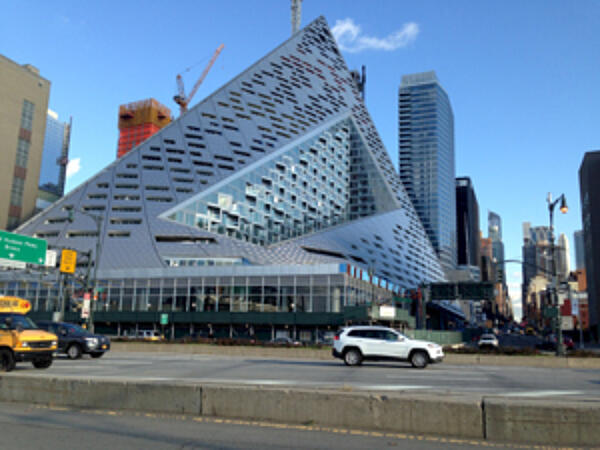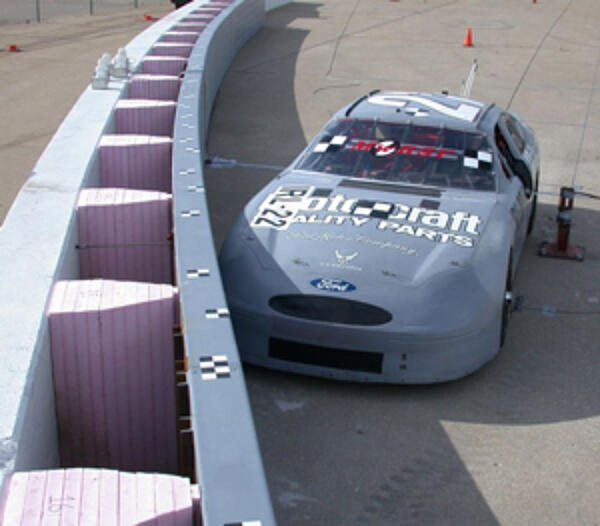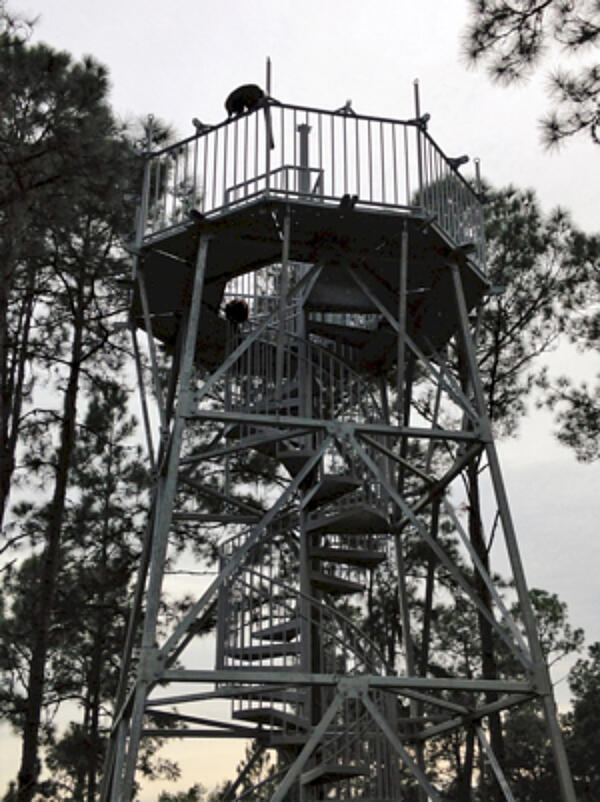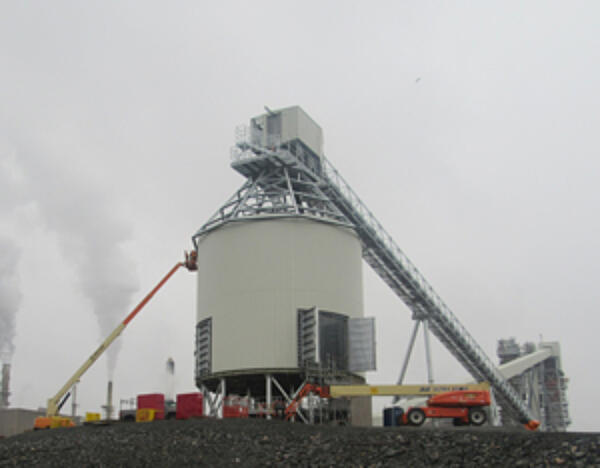The 2016 Excellence Awards Showcase Ingenuity, Innovation
CENTENNIAL, CO - The American Galvanizers Association (AGA) is pleased to announce the winners of the 2016 Excellence in Hot-Dip Galvanizing Awards. More than 120 projects were submitted representing the versatility of hot-dip galvanizing. All submissions were judged online by a panel of architects and engineers and are now featured in the AGA Project Gallery.

This year’s winners showcase creative and innovative uses of the hot-dip galvanized coating. The highest honor, designated Most Distinguished, was given to the Pyramid Residential Building, VIA 57West, in New York, NY. The architects, Bjarke Ingels Group (BIG) used ingenuity in the design of the building, ensuring ample green space, wonderful views, and little traffic noise. Hot-dip galvanized steel, which provides the frame of the 467-foot pyramid, was the right product for the goal of maintenance-free longevity to help BIG create a structure that stands out in a city where so many other iconic structures stand.

The Lifetime Achievement Award was granted to the Marketplace Center in Boston, MA. This special award recognizes galvanized projects with at least 15 years of service and are also featured in the AGA’s Galvanized Steel Studies (GSS). GSS are YouTube video interviews with the owners and/or specifiers of the projects detailing its performance over the years. The Marketplace Center, adjacent to Faneuil Hall, was redeveloped in the late 1960s, and the “Walkway to the Sea” was constructed in 1985utilizing a duplex system of hot-dip galvanizing and paint. The steel framed, glass-canopied structure was designed to allow pedestrians to walk directly to the waterfront, and the duplex system provides both aesthetics and corrosion protection to the structure.

On the other side of the country, the 101 Freeway Overcrossing in Los Angeles, California, also employs a dual protection system, and is the winner of the Duplex Systems category. The Overcrossing was constructed to connect the city’s historic district to the financial and civic districts on the other side of the 101. The city wanted the overcrossing to have a spangled, metallic finish, but the galvanizers explained the chemistry of the steel would dictate the coating finish and would change over time as the zinc coating weathered. Not to be deterred from the original vision, the city took an innovative approach and opted to have the spangle pattern painted onto the surface using a detailed stencil. Now, the arc-canopy pedestrian crossing is not only functional, but also an enhancement to the landscape.

Another project highlighting the beauty of hot-dip galvanizing was the Mammoth, which took home the Artisitc Award. Located on a well-traveled trail head on the Guadalup River in San Jose, CA, a galvanized bent-pipe sculpture of an enormous adult mammoth stands, towering over 12 feet tall and 18 feet long weighing in at a massive five tons. It is truly a sight to behold. The Lupe Grande sculpture was created so no one forgets these gentle giants who roamed the North American Territory so many millennia ago. There is a sense of pride that hot-dip galvanizing played such a critical role in creating this magnificent tribute to this amazing animal – a tribute that will boldly withstand the rigors of time and the elements, thanks to the magic of hot-dip galvanizing.

There were also a number of projects that utilized hot-dip galvanizing in a more pragmatic, utilitarian way, such as the winners in the Bridge & Highway and Transportation categories. There were two Bridge & Highway winners, both featuring rehabilitation of older bridges. The first is the Indian Mill Bridge, a single lane vehicular steel truss bridge that allows access to the Indian Mill in Wyandot County, Ohio, originally built in 1861. The old steel truss bridge had stood for more than 100 years, but in 2010, the local community leaders deemed it functionally obsolete and in desperate need of repair. So, in 2015, the local galvanizer and bridge manufacturer helped restore the bridge, even reusing some of the original 100-year old steel, to ensure access to this historic site.

Though the other Bridge & Highway winner is also a rehabilitation project, it is very different than its counterpart. The Rehabilitation of the Longfellow Bridge (Phase 1), is part of a $270 million, multi-year project in Boston, MA. The Longfellow is a combination railway and highway bridge, and is one of the busiest in the Commonwealth connecting Boston to Cambridge. The bridge has been on the National Register of Historic places since 1976, so the project required special consideration to safely repair the bridge while maintaining its historical integrity. One aspect of the project includes removing the existing steel arch ribs, galvanizing them, and reinstalling. The hot-dip galvanizing, and some duplex coated parts, will help the iconic bridge resist corrosion for decades to come.

The Transportation winner is also a pragmatic infrastructure element, but it also mixes in some aesthetic appeal. The MDX 836 ORT is an open road tolling system, which collects tolls via license plates or radio-frequency transponders so vehicles do not have to stop. Although the purpose of the toll structure is about functionality, the MDX authority saw the value in designing it as a gateway to the Caribbean and Latin American culture of Miami. The 85-foot wing gantry, which utilizes hot-dip galvanized steel to resist the salty, humid Miami air, is lit up with different colors intermittently to welcome visitors and commuters to the lively city.

Also marrying functionality and beauty were the winners in the Building & Architecture and Recreation & Entertainment categories. The Scott Family Amazeum took home the Building & Architecture award. This project truly displays the combination of fun and functionality that HDG provides, by executing a design featuring interactive indoor and outdoor learning spaces. The Scott family was determined to have an eco-friendly, green Amazeum that could endure not only the outdoor elements, but also the constant use from thousands of children. Galvanizing these steel structures ensured they will provide the necessary maintenance-free durability, and add to the overall sustainability message of the project that the family intended.

Similarly, the Rolland Beaudin Outdoor Stage in historic Quebec City, was developed to provide visual impact while protecting entertainers and equipment in this outdoor park. A wide variety of musical acts as well as comedy and variety shows entertain local audiences in this urban park. The new stage was designed to be sturdy, but have a flair of “lightness” to symbolize a bird taking flight. The curved “wings” and frame of the structure were hot-dip galvanized to provide durable, long-lasting corrosion resistance, for present and future generations to enjoy the performances while gazing at the stars.

The winning projects in the Electric, Utility, & Communication, Original Equipment Manufacturing (OEM), and Water & Marine categories all feature galvanized steel in innovative structures. The AEP Bold™ Transmission structures are a revolutionary, high-efficiency solution to the power transmission and distribution market. The high-capacity, efficient galvanized steel structures boost capacity with a lower profile, eye-pleasing crescent-shaped crossarm design. These innovative poles marry form and function,
delivering more power while using less right-of-way.

Following the same theme, the next two winners are innovations in safety structures. The Original Equipment Manufacturing (OEM) winner is the NASCAR SAFER® Barriers. These barriers lessen the chance of injury and reduce vehicle damage by distributing the impact load to energy-absorbing foam cartridges. The first barriers were installed in Indianapolis in 2002, and due to their performance, the barriers have been installed in critical areas of NASCAR and INDYCAR tracks throughout the U.S. Because the barrier systems are constantly exposed to the elements, it was critical to protect the steel panels and components to ensure proper functionality. Therefore, the barrier systems utilize hot-dip galvanized steel and some duplex coatings for branding, to ensure these important safety features are race-ready for generations.

The Navy Security Fence & Gates won the Water & Marine Award this year. These structures are also employed for safety by the United States Navy. The modular structures are utilized to create basically a floating fence, to keep unwanted sea vessels from penetrating inland ports. Because the flotation fences are submerged in salt water, and moved around, it was important to specify a durable protection coating. Hot-dip galvanized steel was “tested” on a few of these innovative safety structures a few years ago, and their performance reinforced the Navy’s decision that hot-dip galvanizing was the correct choice to help protect these structures, and in turn, our troops.

In the Food & Agriculture and Civic Contribution categories, hot-dip galvanizing is once again the backbone in some innovative, research facilities in Florida. The Agromillora Florida Greenhouse Project, which took home the Food & Agriculture award, was built to help combat a bug infestation threatening citrus plants. The greenhouse will use genetic modifications and other innovative solutions to try to develop resistant or tolerant plants. The very nature of a greenhouse is to develop a warm, humid environment which is extremely detrimental to steel structures. Add in the consistent irrigation of the plants and the tropical Florida climate, a quality corrosion resistance system is a must. Hot-dip galvanizing will ensure the steel structures have the corrosion protection necessary to continue this important work.

Taking our Civic Contribution Award this year was the Natalee Lee Quay Lemur Lotus Tower, located in the small town of Myakka City, FL. The Myakka City Lemur Reserve is 120 acres of various woodlands, marsh, and wetlands providing a variety of habitats for more than 52 lemurs from six species. The Lemur Conservation Foundation (LCF) desired for this observation tower to be not only functional for both the lemurs and for the scientists and researchers, but also aesthetically pleasing and artistic. In order to support the LCF, many hours of design, engineering fabrication, galvanizing, and installation were done free of charge or at a reduced rate as additional contributions. The need for maintenance to this structure due to corrosion will be minimal, so the animals and facilities will not need to be disturbed.

The last of the 2016 Excellence Awards winners are two Industrial projects that demonstrate durability and ingenuity. The Iowa Fertilizer Company (IFCo) utilized hot-dip galvanizing because of its proven track record in the Petro-Chemical industry as it is able to withstand the corrosiveness and abrasiveness of the environment. In addition to the durability in an aggressive environment, hot-dip galvanizing offered cost effectiveness, expedited delivery, and long-term corrosion control.

Finally, the Irving Pulp & Plant in Saint John, New Brunswick also won an award in the Industrial category, as the project utilized hot-dip galvanizing for its tough, long lasting protection of steel. The project was originally slated to be painted, but after the specifiers understood the initial cost of hot-dip galvanizing was competitive with the high-performance paint system, the specification was converted. Hot-dip galvanized steel added substantial value to the project because of its long-life and ultra-low maintenance. Even in the aggressive, corrosive environment of a pulp and paper mill, galvanized steel will serve the interests of Irving Pulp & Paper with maintenance-free longevity for decades to come.
Congratulations to all of this year’s winners, which will be featured in Winners section of the AGA Project Gallery as well as s on the AGA homepage (galvanizeit.org), various publications, seminars, and other marketing materials. All of the projects submitted to the 2016 competition will be added to the Case Studies section of the AGA Project Gallery.

